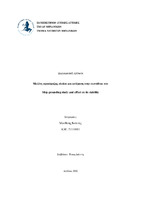| dc.contributor.advisor | Τίγκας, Ιωάννης | |
| dc.contributor.author | Μπεθάνης, Ιωάννης | |
| dc.date.accessioned | 2022-12-14T07:03:34Z | |
| dc.date.available | 2022-12-14T07:03:34Z | |
| dc.date.issued | 2022-12-07 | |
| dc.identifier.uri | https://polynoe.lib.uniwa.gr/xmlui/handle/11400/3488 | |
| dc.identifier.uri | http://dx.doi.org/10.26265/polynoe-3328 | |
| dc.description.abstract | Η παρούσα εργασία έχει ως σκοπό την μελέτη προσάραξης πλοίου με χρήση της μεθόδου των πεπερασμένων στοιχείων και την μελέτη της επίδρασης της προσάραξης στην ευστάθεια του πλοίου. Στο θεωρητικό μέρος γίνεται αναφορά σε στατιστικά και φωτογραφικά στοιχεία που αφορούν το ατύχημα της προσάραξης. Επιπλέον, γίνεται αναφορά στην εξέλιξη των κανονισμών ως προς τα μέτρα που λαμβάνονται κατά τη σχεδίαση για την αποφυγή των συνεπειών της προσάραξης. Στο θεωρητικό μέρος γίνεται επίσης περιγραφή της μεθόδου των πεπερασμένων στοιχείων και της μη γραμμικής ανάλυσης με αυτή τη μέθοδο. Ενώ, γίνεται και αναφορά σε μελέτες σχετικά με την ανάλυση της προσάραξης με τη μέθοδο των πεπερασμένων στοιχείων. Στο τεχνικό μέρος της εργασίας, περιγράφεται το σενάριο προσάραξης που εξετάζεται, παρουσιάζεται το μοντέλο του αμπαριού και των υφάλων που χρησιμοποιήθηκαν για την ανάλυση, περιγράφονται οι σχεδιαστικές παραδοχές που έγιναν στο μοντέλο, αναλύονται οι ρυθμίσεις της ανάλυσης ως προς την επιλογή των ιδιοτήτων των υλικών, την εισαγωγή των ιδιοτήτων της γεωμετρίας, την σύνδεση μεταξύ των στοιχείων του μοντέλου, την δημιουργία του πλέγματος, την επιλογή της ταχύτητας της ανάλυσης, την επιλογή των οριακών συνθηκών και των ρυθμίσεων της ανάλυσης. Κατά το πέρας των παραπάνω, παρουσιάζονται οι αναλύσεις που πραγματοποιούνται και αξιολογούνται τα αποτελέσματα ως προς την αξιοπιστία τους, ως προς την επίδραση διάφορων ταχυτήτων στα αποτελέσματα, ως προς την επίδραση της έκτασης του μοντέλου, ως προς τον ενεργειακό ισολογισμό και ως προς την απόκριση της κατασκευής με βάση τις αρχές της μηχανικής. Στο τελευταίο μέρος της εργασίας εξετάζεται η ευστάθεια του πλοίου μετά από προσάραξη. Παρουσιάζεται η γάστρα που χρησιμοποιείται, περιγράφονται οι καταστάσεις φόρτωσης και τα σενάρια προσάραξης που εξετάζονται και τέλος αξιολογούνται τα αποτελέσματα με ορισμένα κριτήρια ευστάθειας του Διεθνή Ναυτιλιακού Οργανισμού (IMO – International Maritime Organization). | el |
| dc.format.extent | 177 | el |
| dc.language.iso | el | el |
| dc.publisher | Πανεπιστήμιο Δυτικής Αττικής | el |
| dc.rights | Αναφορά Δημιουργού - Μη Εμπορική Χρήση - Παρόμοια Διανομή 4.0 Διεθνές | * |
| dc.rights | Attribution-NonCommercial-NoDerivatives 4.0 Διεθνές | * |
| dc.rights.uri | http://creativecommons.org/licenses/by-nc-nd/4.0/ | * |
| dc.subject | Μέθοδος πεπερασμένων στοιχείων | el |
| dc.subject | Προσάραξη πλοίου | el |
| dc.subject | Ευστάθεια πλοίου | el |
| dc.title | Μελέτη προσάραξης πλοίου και επίδραση στην ευστάθειά του | el |
| dc.title.alternative | Ship grounding study and effect on its stability | el |
| dc.type | Διπλωματική εργασία | el |
| dc.contributor.committee | Θεοδουλίδης, Αλέξανδρος | |
| dc.contributor.committee | Πέππα, Σοφία | |
| dc.contributor.faculty | Σχολή Μηχανικών | el |
| dc.contributor.department | Τμήμα Ναυπηγών Μηχανικών | el |
| dc.description.abstracttranslated | The purpose of this diploma thesis is to study the grounding of a ship using the finite element method and to study the effect on its stability due to grounding. In the theoretical part, reference is made to statistical and photographic data concerning grounding accidents. In addition, reference is made to the development of regulations regarding measures taken during design stage to avoid the consequences of grounding. The theoretical part also describes the finite element method and the nonlinear analysis with this method. At this part reference is also made to studies on the analysis of grounding with the finite element method.
In the technical part of the paper, the considered grounding scenario is described, the cargo hold and reef model used for the analysis is presented, the design assumptions made in the model are described, the analysis settings are analyzed in terms of material properties selection, in terms of the selection of the geometry properties, in terms of the connection between the model elements, in terms of the creation of the mesh, in terms of the selection of the analysis speed, in terms of the selection of the boundary conditions and in terms of the analysis settings. At the end of the above, the analyzes carried out are presented and the results are evaluated in terms of their reliability, in terms of the effect of various speeds on the results, in terms of the effect of the extent of the model, in terms of the energy balance and in terms of the response of model based on engineering principles. In the last part of the paper, the stability of the ship after running aground is examined. The hull used is presented, the loading conditions and grounding scenarios considered are described and finally, the results are evaluated with some of the stability criteria of the International Maritime Organization (IMO). | el |


